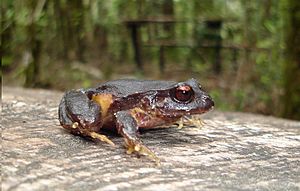Rosy ground frog facts for kids
Quick facts for kids Rosy ground frog |
|
|---|---|
 |
|
| Conservation status | |
| Scientific classification |
The rosy ground frog, also known as Eupsophus roseus, is a small frog that belongs to the Alsodidae family. This special frog is found only in Chile, a country in South America. It lives in cool, wet places like forests and swamps.
Contents
What is the Rosy Ground Frog?
The rosy ground frog gets its name from its reddish or pinkish color, which helps it blend in with the ground and leaves. These frogs are usually quite small. They have smooth skin and strong legs, perfect for hopping around their forest homes. Like all frogs, they are amphibians, meaning they can live both in water and on land.
Where Does It Live?
The rosy ground frog lives in specific parts of Chile. Its favorite places are temperate forests, which are forests with moderate temperatures and plenty of rain. You might also find them near rivers, in swamplands, or in temporary freshwater marshes. These marshes might dry up sometimes but fill with water again later. These wet environments are very important for the frogs, especially for laying their eggs.
What Does It Eat?
Rosy ground frogs are carnivores, which means they eat other small creatures. They mostly hunt tiny invertebrates like insects, spiders, and worms. They use their long, sticky tongues to catch their prey quickly. Eating these small animals helps keep the ecosystem balanced.
Life Cycle and Reproduction
Like many frogs, the rosy ground frog goes through a fascinating metamorphosis. This means it changes a lot as it grows up.
How Does It Grow?
The life of a rosy ground frog starts as an egg. The female frog lays her eggs, often in wet places or even under logs and leaves. After a while, the eggs hatch into tadpoles. Tadpoles live in water and look more like tiny fish than frogs. They have gills to breathe underwater and tails to swim. As they grow, tadpoles slowly change. They start to grow legs, their tails get shorter, and their gills change into lungs, allowing them to breathe air. Eventually, they become tiny froglets, ready to leave the water and explore the land.
How Do They Reproduce?
When rosy ground frogs are ready to have their own babies, they find a mate. The male frog often calls out to attract a female. After mating, the female lays her eggs in a safe, moist place. This cycle ensures that new generations of rosy ground frogs continue to live in their Chilean homes.
Why Is It Important?
The rosy ground frog is an important part of its ecosystem. It helps control insect populations and also serves as food for other animals. Sadly, this frog is currently considered "Least Concern" by conservation groups, but it faces a big problem: habitat loss. This means that the places where it lives are disappearing or being damaged. When forests are cut down or wetlands are drained, the frogs lose their homes and places to find food and lay eggs. Protecting their habitats is very important to make sure these unique frogs can survive for many years to come.


